The story of Blossom Seeley is complex and varied, and some parts of it may never be known. While it was made into a Hollywood biopic in 1952, the actual story of her life was much too racy for that time, and even one of her famous friends who had helped facilitate the production of the film felt the treatment was too mild. What this account is going to attempt to do is shed new light on many facets of Seeley's life. It will also present newly unearthed information that will, in many cases, contradict what has been previously accepted about Seeley, and will hopefully become accepted as a more accurate and logical narrative of her life, starting with her introduction as a young ragtime singer. Each of the widely disseminated myths will be addressed and countered with more accurate or likely information.
Origins
Two items long questioned are Ms. Seeley's year of birth and her birth name. The first appearance of the name Blossom Seeley located was in late 1901 in San Francisco, California. She had been known a bit before then as "Little Blossom." One source gives her birth name as Blossom Katherine Seeley, and Katherine was indeed used on one of her marriage certificates. It also claims that her mother's name was Bertha. Blossom also asserted later in life that she was born in San Francisco in 1891, and that is the year shown on her Social Security record. Another name she was known to have used was Minnie Guyer, which, according to her great niece may have actually been spelled Guiger. Her mother was also referred to as Minnie while growing up, including at a commencement for her school in 1885 where the Guyer spelling was utilized in the Daily Morning Journal and Courier of June 30. There are circumstances and information to contradict at least some of these parameters, and it does make a difference concerning perception and certain events.
Seeley could have easily claimed to have been born in San Francisco, California in 1891 since most of the existing birth and marriage records were destroyed as a result of the April 18, 1906 earthquake and subsequent fire that devastated the city. However, the 1910 census has a listing for Blossom Seeley, theater actress, in Los Angeles, claiming to have been born in Kentucky, as well as her parents, and her age to be 25. Reports in the Los Angeles Times and Herald show a vaudeville production that was in town at that time which she was known to have performed in, and Seeley was no stranger to Los Angeles by 1910.
But perhaps the most reliable information was found on an aborted 1903 Michigan marriage record, which showed once again the consistent 1885 year, but a birthplace of Connecticut. Since that state was also mentioned several times over the years in conjunction with Blossom, it turns out it was the best fit. It also listed her father's name as Winton Seeley (possibly a misspelled attribution to her mother's maiden name of Winson), which was not found in other records, although that may also be misleading. Information generously provided by her great niece, Carol Albrikes, points to a more definitive origin.
Blossom was indeed born as Minnie Guyer (or Guiger) in New Haven, Connecticut, to photographer William F. Guyer and his wife Mertle F. "Minnie" Winson (sometimes seen as Mertie), who had married in 1880. A registry of births from New Haven confirmed her 1886 birth, as well as one for an older brother, William, Jr., in 1881. The 1900 enumeration, taken in New Haven, further indicated a birth year of 1886, but some later sources point to 1885. In spite of how much stretching of that particular truth was done during her storied lifetime, 1886 is now confirmed as the actual year, and for this essay will be assumed so because of the registry and the next earliest citations in both the 1900 Federal and 1905 New York enumerations. It is as yet unclear where the Seeley name came from. Around 1900, according to the census of that same year, Mertle was remarried to James J. Lonergan in Connecticut, and who was only eight or nine years older than Minnie. The 1900 census showed the family residing in New Haven with Minnie as his stepdaughter, and Mertle's mother, Mary A. Winson, also residing with the family. James was listed as a clerk in an unspecified industry. In just over two years, Mertle would give birth to James L. Lonergan (11/30/1902), Blossom's half-brother.
Early Years
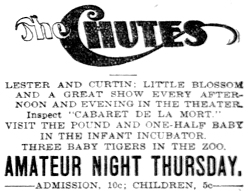 |
Blossom started performing at a fairly young age, but more likely her professional debut as Little Blossom was at age 13 or 14. (Note that there was a Baby Blossom based on the East Coast who performed from the mid-1890s to early 1900s, but performance date conflicts prove that this was a different performer. Also, her last name was Ferguson, her father was John Ferguson, for which no matches can be found related to Miss Seeley, and her implied birth year was 1887 as per some advertisements.) It was common for smaller talented teens to be dressed down to look younger, which would amplify the novelty of their talents. Either her mother or a manager had her appearing in variety theaters and some of the Barbary Coast vaudeville houses and burlesques. Some had amateur nights, and after her introduction as a young "coon shouter" she was able to get work. This was a style of loud singing in a partially contrived Negro dialect involving songs about comic dilemmas. Already established in this field were Ben Harney and May Irwin who had visited the West Coast in the mid-1890s on tour with vaudeville troupes. It is possible that Minnie got her stage name of Blossom Seeley from a promotor or theater manager, rather than from any family member.
Blossom was able to gain some early notoriety around 1900 as her reputation grew. An early mention of her appears in the November 9, 1901 edition of The Music Trade Review, as follows: "Blossom Seeley, the charming comedienne, makes a big hit this season with 'Maizy, my Dusky Daisy.'" There is no mention of her as "Little Blossom" nor of her age, which if she were actually ten would certainly have been worthy of noting. It was in 1900 or 1901 that she was heard by showman David J. Grauman. Coming from Indianapolis, he had organized a traveling vaudeville and minstrel troupe in the 1880s. Along with his eventually more famous son Sidney Patrick "Sid" Grauman, the family had recently participated in the Klondike Gold Rush of 1898. D.J. Grauman soon returned to San Francisco to tend to an ill sister. While trying to launch a venture there he reportedly heard Little Blossom in a bar singing That Teasin' Rag, a myth that should be dispelled since it would not be composed for several more years. However, he still did engage Blossom for his new venture, The Unique Theater, opened around 1902. Many famous entertainers and vaudeville acts would pass through the Unique over the next few years, as well as the Grauman's second theater, the Lyceum.
The Unique Theater was quickly recognized as a quality family-friendly place - the Barbary Coast's home of polite vaudeville - with easy to negotiate ten-cent shows. Grauman was also known to be fair to his performers, and promoted Blossom in her growing talents with syncopated songs. She also developed a style of finger snapping on stage that further engaged the audience. As mentioned above, the earliest notices for Blossom appeared in late 1901, albeit without a specific location indicated. By early 1902 she was being called "The Queen of Grauman's." She was listed in the San Francisco Call and other newspapers as "Blossom Seeley, Coon Shouter," part of a show which included acrobatic dancers Lester and Curtin.
Blossom was soon a part of Fred Irwin's traveling Big Show Company through much of 1902. There are notices for them starting in San Francisco, then playing in Buckingham and Louisville, Kentucky; Saint Louis, Missouri; Boston, Massachusetts; and in Scranton, Pennsylvania in November 1902, where a reviewer said she "is probably the most artistic interpreter of ragtime melody that has been heard in Scranton." The troupe also ventured to the Dewey Theater at Coney Island, New York, in March 1903, the latter which dispels the myth that she was not heard in New York before 1910. The last listing that can be found for her as Little Blossom was at Grauman's Theater in July of 1903, when she would have just turned 17. Also in that show were the dancers Lester and Curtin, who had been part of Irwin's troupe for some time.
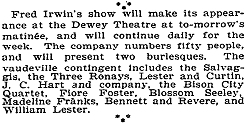 |
There is another myth to be quashed concerning Seeley which also reinforces the probability of an 1886 birth year over that of 1891. Virtually all biographies to date have noted she was married three times. There was another marriage, however, that preceded the other three. As noted, one of the acts she often appeared with was Lester and Curtin. William Lester and Patrick William Curtin were known as acrobatic dancers, and often as tumblers. For the 1900 enumeration, Curtin, born in New York around 1874 or 1875, was listed as an actor lodging in Chicago with the rest of his troupe, possibly on their way out west. At some point after a year of working together, Curtin became involved with Blossom, and the pair attempted to get married on February 11, 1903 in Detroit, Michigan. She showed her age as 18, which suggests an 1884 birth year, but that may have been a stretch. As noted in the Detroit Free Press of February 12, 1903, this union was not fully sanctioned by their employer during the tour:
BLOSSOM SEELEY CANNOT MARRY
MANAGER IRWIN DAMPENS THE ARDOR OF TWO BURLESQUERS
MANAGER IRWIN DAMPENS THE ARDOR OF TWO BURLESQUERS
Woe befell the matrimonial aspirations of Miss Blossom Seeley and William Curtin, members of the current attraction at the Empire Theatre, yesterday, when Manager [Fred] Irwin prevented their marriage on account of the tender age of the actress.
Miss Seeley is a winsome lass of 16 [probably 17], although she was declared to be 18 when they secured the license. When she became a member of the company she was placed under Irwin's guardianship by her mother, who lives in New York. Curtin, aged 22 [also a stretch], who does an acrobatic turn, and Miss Seeley, were known to be very attentive to each other for some time, but no one was aware of their intentions until yesterday. Mr. Irwin threatened Curtin with dismissal if he did not surrender the license. This Curtin refused to do and the manager at once took the young woman under his personal care.
In answer to a telegram to the girl's mother Mr. Irwin, last night, received instructions to positively forbid the marriage.
Later that year they started appearing as their own act, "Curtin and Blossom, The Acrobat and the Soubrette." The pair were finally married in 1904 in either California or Connecticut, which would have made her at least 18.
In addition to that they had a child, Margaret I. Curtin, born September 25, 1904 in Santa Rosa, California. Any existing certified evidence of the marriage or Margaret's birth were likely destroyed in the San Francisco fire of 1906. However, there is mention of them in the New York Times in June of 1911 when Seeley was seeking a divorce from Curtin. From 1905 to 1910 both of them continued to perform, but not always on the same stage. Her act at that time was a combination of syncopated ragtime songs and comic "Negro-dialect" stories, and she was most often billed as a singing comedienne. It is curious, then, that Blossom was listed (as Minnie) in the June 1905 New York state census still as a member of the Lonergan household. Even though they showed her as living there and working as an actress, this could be a false positive as her mother was simply accounting for her despite her possible absence from their home. However, if she was indeed there, her daughter Margaret may have been with the Curtin family, who appear to have raised their granddaughter in part.
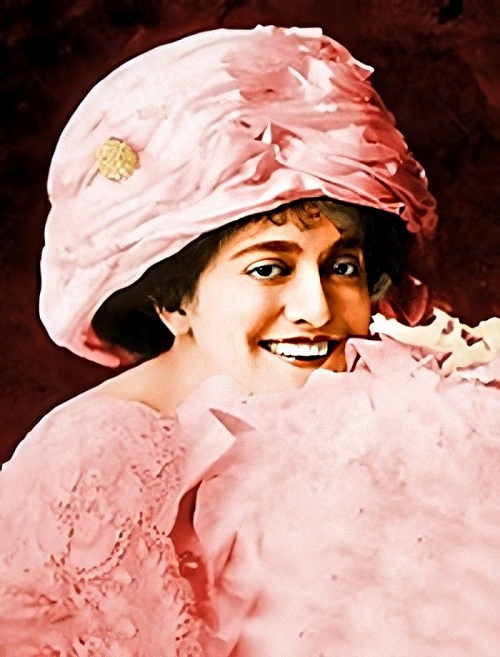 |
Another myth perpetuated in the biopic Somebody Loves Me involves the famous aforementioned earthquake. The likelihood that Blossom was on stage performing when the earthquake occurred is likely erroneous since the event started at 5:12 AM, long after most San Francisco audiences and entertainers would have left the stage and the theater. A similar myth is shown in the 1936 film San Francisco. While the night life in some vaudeville houses went well into the morning hours, there was often a lull after 3:00 AM which would pick up again after around 9:00 AM, and performers were not typically on call for 24 hours at a time. Research in newspapers of the time found no confirmation either way of a 24-hour vaudeville house in San Francisco at that time. Blossom was possibly in town, however, so may have at least experienced the earthquake.
Some stories circulating about Blossom's stage exploits during these years of travel described one particular interesting tidbit. It seems that while singing and strutting she would hold a tiger's head between her thighs, and either she or some of the other performers encouraged men in the audience to toss coins into its open mouth, a great gimmick for increasing personal revenue.
Starting around 1908 there is another name the surfaces often along with Seeley. As noted in the San Francisco Call on August 9, 1908, "Mike Bernard and Blossom Seeley, who recently made a tremendous hit in New York, will present an amusing sketch which enables Bernard to display his extraordinary skill as a ragtime pianist and Miss Seeley to exhibit her excellence as a singing and dancing comedienne."
Mike Bernard was perhaps the most famous ragtime pianist in New York at that time, and despite quite a bit of Barbary Coast competition was able to manage to gain a good reputation in the West as well. There is a chance that Bernard, who had recently been divorced from his young wife May Agnes Convery, became involved with Seeley while on the tour. By late 1908 Blossom had moved to Los Angeles for a while, engaged for a long run at a vaudeville house there. A notice in December has Bernard and Seeley on the same bill as George Bloomquest, Franklin Underwood and Frances Slosson playing at the Orpheum.
Blossom was back in San Francisco in April of 1909 with Mr. Bernard, and managed to make the news in a dramatic fashion. According to the Oakland Tribune of April 19, 1909, Blossom had downed a bottle of Lysol three nights prior in a suicide attempt that followed an argument with the pianist. He drove her to Central Emergency Hospital to have her stomach pumped. She recovered sufficiently and went back on stage at the National Theater in San Francisco. That appears to have been the end of their relationship.
From West to East
Around this same time Blossom was seen by stage comic singer Joseph Cahen who used the stage name of Joe Kane.
After her initial Los Angeles run Cahen convinced her to tour with him for a while, and they appeared in several theaters on both coasts. One notice in the San Francisco Call on August 10, 1909, noted that:
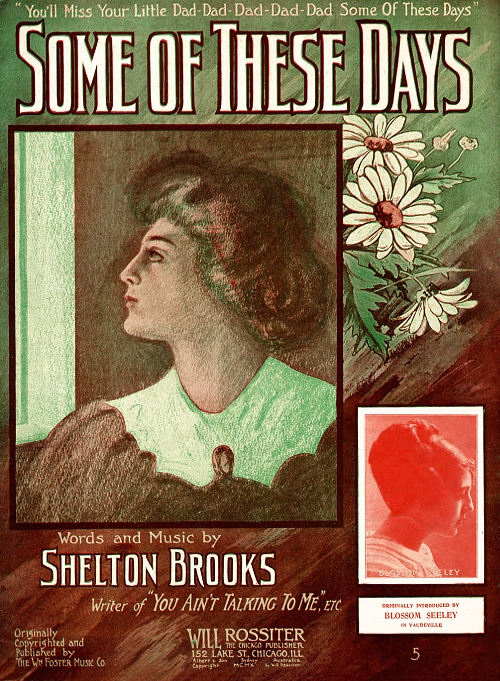 |
Blossom Seeley, than whom no friskier soubrette has appeared in San Francisco for many a day, gave an imitation of herself going crazy in the three performances of 'The Pride of The Harem' at Fischer's theater yesterday, and, in addition, she sang 'Put Your Arms Around Me, Dearie' and George Cohan's latest coon divertisment [sic], 'The Rag Baby.' Miss Seeley's efforts were rewarded with enthusiastic applause and she left her audiences 'hungry,' as the vaudevillians say.
Joe was usually not mentioned in the notices, and may have simply taken more of a back seat role in Blossom’s continuing success. The pair had returned to Los Angeles by late 1909.
This is where Blossom was found in a 1910 Los Angeles directory, and for the 1910 census taken April 27, listed as a Theatrical Actress, but also shown to be single. In the meantime, Curtin had settled back in Brooklyn with his parents. He was listed as an actor in the 1910 census, married, and with his five-year old daughter Margaret who was born in California. Cahen was by now convinced that he would be better off managing Blossom's career than trying to continue with his, so he became her manager. He was also very much in love with her by this time, so was willing to make these sacrifices for Seeley. He managed to get her picture on the cover of one edition of the latest hit Some Of These Days by Shelton Brooks.
Late in 1910 things started to move forward for Blossom as, possibly through Cahen's efforts, she was engaged by the famed showman Lew Fields to move back East and become part of his vaudeville family. Blossom was put into the show The Hen Pecks which opened at the Broadway Theater on February 4, 1911. Also in the cast was Lew Fields as the father to four daughters, including Blossom, dancer Vernon Castle, and notable vaudeville and stage actors Lillian Lee, Gertrude Quinlan, Ethel Johnson, Laurence Wheat, Edith Frost and Stephen Maley. The reviews for the show were good, as were reviews for Blossom and her command of the syncopated melodies she sang. Her presence was reportedly one of the reasons for the show's fairly long run.
In the show she played aspiring chorus girl Henella, faced with the real-life dilemma of a life as a wife or one in show business. Blossom belted out the song Toddlin' the Todalo and then danced the Texas Tommy, a west coast step, on a table, a stunt reportedly concocted by Fields to show off her shapely legs. In fact, Blossom's dancing antics were said to have popularized certain dance crazes in New York in 1912 and 1913. Audience reaction was enthusiastic, and her fame was spread by word of mouth, and by gossip. Blossom also recorded her first solo side for Columbia in May, but it would be another decade before any more recordings followed.
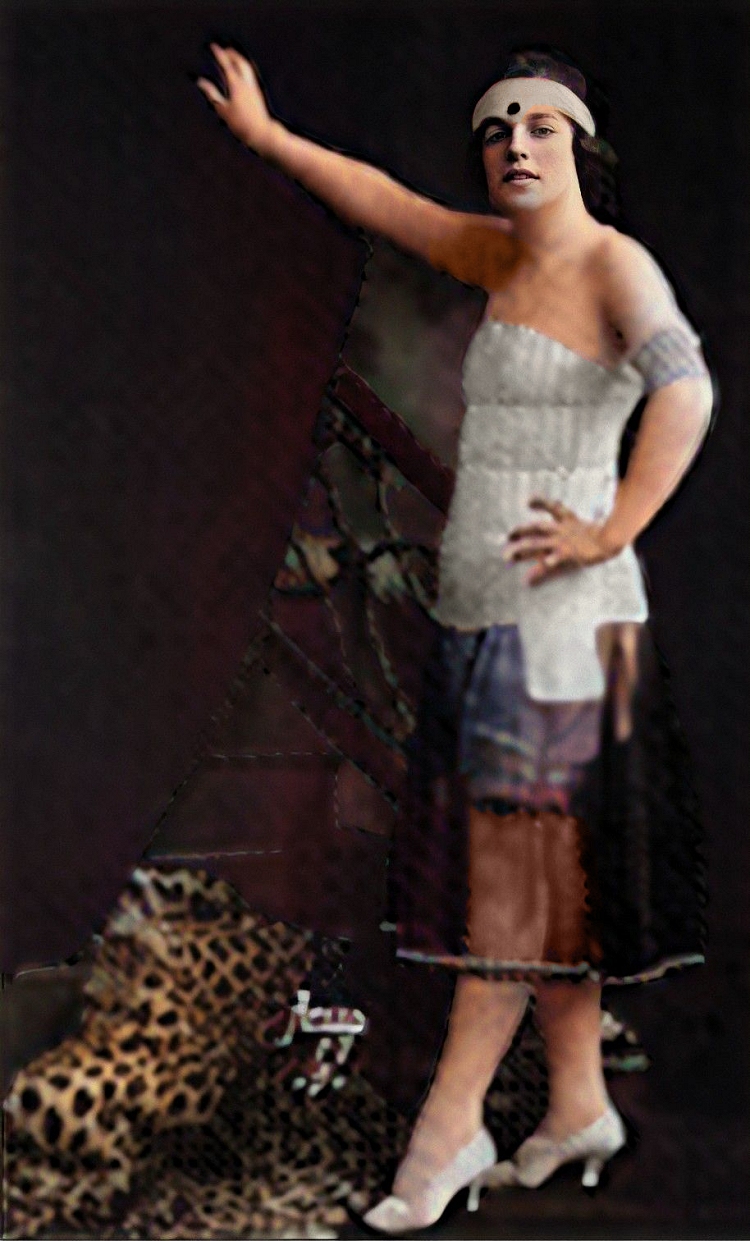 |
By summer things were getting messy for the rising star, who at that time was residing in New Haven, Connecticut, possibly with Cahen. According to an article in the New York Times of June 3, 1911:
Blossom Seeley, an actress, who is known off the stage as Minnie Guyer of this city, today filed suit for divorce against William Patrick Curtin [he often used Patrick William], formerly a New Haven man, but now a resident of Brooklyn. She alleges intemperance and intolerable cruelty. Curtin immediately filed a counter bill against his wife, naming Michael Bernard, a Western man, as co-respondent, and adding desertion to the offense alleged. The couple were married here in 1904, and next year Mrs. Curtin's parents were divorced. Mr. and Mrs. Curtin have a daughter, Marguerite [sic], who is 5 years old. Each of the parents seek the child's custody.
By this time Bernard was likely not a factor for the alienation of affection (a veiled term for adultery often used in the newspapers), but he was a name that Curtin knew. In the end, Curtin gained custody of Margaret, the only known daughter of Blossom Seeley. Curtin appears again in the 1920 census living with his father and Margaret, but now in the lumber business and no longer an actor. There was one later ignominious mention of him in the New York Times on June 2, 1922 involving his arrest for public intoxication (during prohibition, no less) for which he was sent to prison for three days. It further notes that Curtin was wounded several times in the war, and that he was the first husband of actress Blossom Seeley.
As it turns out, the man in the wings was Joe Cahen who had helped guide her success. They married on October 1, 1911, in Jersey City, New Jersey, but she kept her stage name in public, known as Mrs. Kane only by their closest friends. However, there was discomfort from the start of this union, and it was not destined to last for long. In March of 1912, Blossom was elevated to star status nearly matching that of three other ladies of the New York stage, Nora Bayes, Sophie Tucker and Fannie Brice, that latter with whom she became a close friend. She appeared on stage in the mixed show A Night with the Pierrots and The Whirl of Society playing at the Shubert Brother's Winter Garden Theater. Another cast member was also on his way to fame, although not yet a star, a young Al Jolson, who brought notice with his rendition of My Sumurun Girl performed with Stella Mayhew. Other songs introduced in this show included Row, Row, Row and Waiting for the Robert E. Lee, both of which have enjoyed a century of popularity since their debut.
Success, Controversy and the Rube
In September of 1912, after the previous show had closed, Blossom played in The Charity Girl in Chicago. The show moved to New York in October, but did not fare well with reviewers. Blossom's single solo song in the play was evidently "universally condemned for its vulgarity" and dropped after the first performance.
She soon left the show when it moved to Boston, and ironically it was Joe that booked her into her next act. New York Giants pitcher Richard "Rube" Marquard (Marquardt at birth) followed the same off-season routine as some of his peers, appearing on the vaudeville stage at the Hammerstein Theater in 1911. For his second stint on the stage he was paired with Seeley by Cahen in a skit titled Breaking the Record of The 19th Straight, referring to his record setting streak of 19 straight wins as a pitcher in the 1912 season. The pair immediately clicked, and their torrid affair began fairly soon. The show opened at the Hammerstein, and it quickly attained success. Included in it was a song with lyrics co-written by Marquard and Thomas Gray, with music co-composed by Blossom and W. Ray Walker, called The Marquard Glide. It too was popular and quickly became a best seller in sheet music form. Before the first week of the show was up, Seeley confessed her romance to Cahen, and in later documents she claimed that he threatened her with a gun, resulting in her getting a restraining order against her husband.
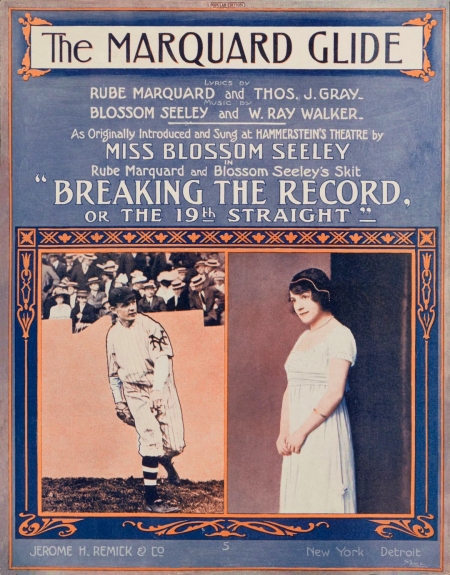 |
The situation escalated in early November when Rube and Blossom escaped to Atlantic City, New Jersey. Cahen found out where they had gone and pursued them. The story of what happened appeared in the New York Times of November 9:
Accompanied by two New York detectives, Joseph Kane bounced into the Hotel Dunlop here early this morning and began to make things unpleasant in the very same way which his wife, Blossom Seeley, had found so objectionable when she was playing at Hammerstein's in New York. On that occasion she appealed to Magistrate O'Connor to have Kane put under bonds to keep the peace because, she said, he was insanely and preposterously jealous of Mr. Marquard - Rube Marquard, the southpaw pitcher of the Giants - whom she finally decided to have as her manager instead of Mr. Kane.
It was 2 o'clock this morning when Kane finally pounded on one of the doors in the hotel and broke his way in, but by that time the two occupants had gone out walking. They left at a brisk athletic pace by way of the fire escape, and now Kane is looking for the wonderful Rube with a warrant charging him, for one thing, with having alienated his Blossom's affections.
The warrant that Cahen was hoping to have served was for adultery, at that time punishable by up to a year in prison. As it turns out, the couple had been seen days before kissing in public at McGowan's Pass Tavern in Central Park. Cahen told a slightly different story about the hotel encounter than Rube, and insisted that he and the lawmen were merely waiting for the couple in the lobby. Either way, the pair did escape, and then caught the next train to Philadelphia. The following week this story became very public as, according to the Times, Cahen launched a suit against Marquard for, as it was politely described, alienation by loss of affection of his wife.
Cahen was asking for $25,000 from Marquard for having ruined his marriage and home life. The publicity did not seem to hurt Marquard at all, and he and Seeley ended up getting more bookings. They appeared at Union Square Theater just before Thanksgiving, followed by a week at the Fifth Avenue Theater, before leaving on a tour.
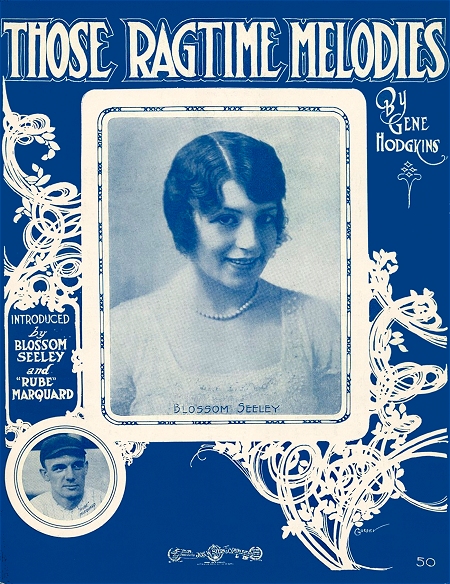 |
In December, as things started to cool down with Cahen, and according to the New York Times of December 10, 1912, Rube even got the confidence to ask his team manager, John McGraw, for a significant salary boost to an unheard of $10,000. McGraw demurred, asking what Rube had done to deserve such a raise, to which Rube pulled out two good points. He had helped the Giants to the pennant in 1912 with his pitching prowess, even winning two of the World Series games, and that he would be just fine quitting the team since he and Blossom were booked for 22 weeks through at least June 1st. That drama continued through the off season, but Rube did report for Spring Training in spite of his continued threats. In the meantime, Cahen successfully filed for and received a divorce from Blossom, finalized on January 15, 1913, and signed by "Supreme Court Justice Hendrick" according to the Times, also noting that it was part of a record session for husbands who had filed for divorces. Yet that story was not quite over yet.
Blossom and Rube continued their successful tour into the spring. Once it was legal to do so, they applied for a marriage license in San Francisco. According to a report from San Francisco on March 11, 1913:
Rube Marquard, the New York pitcher, and Miss Blossom Seeley, who have been playing an engagement in vaudeville at a local theater, today took out a marriage license. It is rumoured that this will be Marquard's final week in vaudeville, and that he will leave in a few days for Marlin to join the other New York players. They will be married here tomorrow.
Concerning his other pending situation, it continued:
Marquard has refused to make any definite assertion about his intention of joining the Giants, although he was quoted during the Winter months as making many pointed remarks about Manager McGraw and threats to retire from the game. During the last few days he has repudiated most of these interviews, but he is evidently waiting to learn what sort of a welcome is in store for him at Marlin before he decides to report. Reports from the New York training camp are the Rube will start for there early next week.
This, of course, would mean that Blossom would have to find a new act to continue her career. In a report on the March 11 nuptials in San Francisco, it was said that:
The marriage ceremony was performed at 4 o'clock in the afternoon in the parsonage of the German Evangelical Lutheran Church, with only theatrical friends in attendance, but with a host of newspaper men and photographers waiting outside. In the marriage license as the big southpaw gave his name as Richard De Marquis [sic], twenty three years of age [a bit off], and his bride as [Blossom] Katherine Kane, twenty two [quite a bit off]. 'Rube' was very nervous. 'He was so anxious to get her,' said the Rev. H.S. Felix, who performed the ceremony, 'that he answered all my questions before I finished them.'
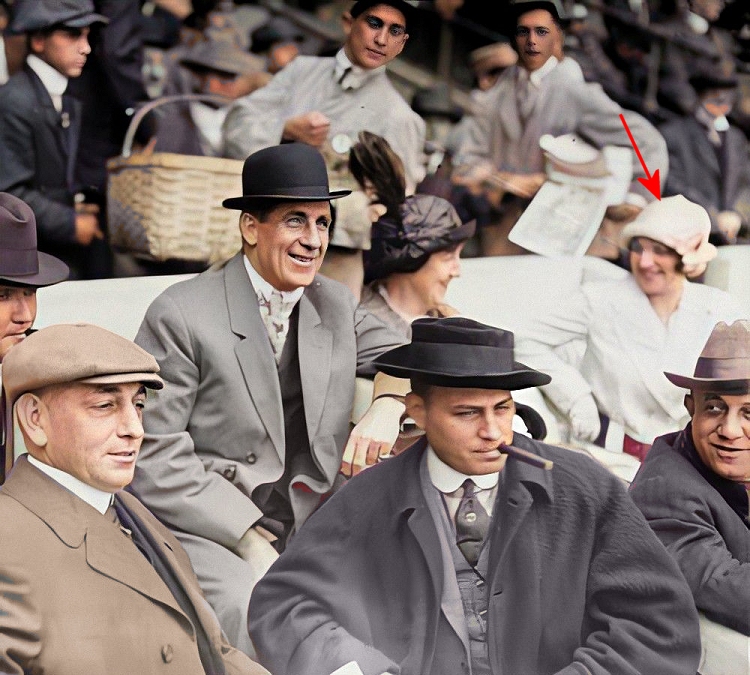 |
"Rube" Marquard, pitcher of the Giants, was all smiles yesterday afternoon when he faced the Boston "Braves" in the afternoon game at the Polo Grounds. The reason therefor [sic] was disclosed in the third inning when Marquard went to bat for the first time.
As "Rube" advanced to the plate the Seventh Regiment band struck up "Here Comes My Daddy New," and the big pitcher blushed and grinned. At their home on Riverside drive "Rube" and Mrs. Marquard, who was Blossom Seeley, welcomed a youngster weighing eight pounds and whose repertoire consists of a series of shrill "bawls."
Blossom would retake the stage not long after that, as Rube's married sister Hattie Kruse appears to have taken over much of the parenting of the boy in Cleveland, Ohio, while his parents each pursued their own careers. She did manage to get some stage work during the 1913 to 1914 season, rejoining her husband with a revision of their previous year's presentation for another tour. Their final encounter with Cahen happened during that tour when they again stopped at the Dunlop in Atlantic City, as was reported by the New York Times on January 15, 1914.
Former Husband of Blossom Seeley Has Old Warrant Served
Atlantic City, NJ, Jan 14: "Rube" Marquard, Pitcher for the New York Giants, and his wife, formerly Blossom Seeley were arrested here last night on a warrant obtained about a year ago by the former husband of Mrs. Marquard. At the time, Marquard was playing with Miss Seeley in a baseball sketch, and both were stopping at the Hotel Dunlop. The former husband, Joseph Cahen, alleged that he had found Marquard in Mrs. Cahen's room late at night. An attempt was made to serve a warrant upon them immediately afterward, but they made their escape through a window and went to New York.
The warrant has been lying here ever since, and Cahen, who knew that his former wife and her husband were playing at the Savoy Theater this week, wired Magistrate Jagmetty, who had issued the warrant a year ago, to have it served.
Mr. and Mrs. Marquard were held under $500 bail for their appearance at the next term of court, which will be held this month. As Miss Seeley was divorced by Cahen and has since been legally married to Marquard, the action of Cahen in causing the old warrant to be served caused a good deal of surprise.
The end result of this action was that Marquard agreed to a $4,000 payment to Cahen to make the situation go away, which it finally did once they settled. Their next argument was with their booking agent, Louis Wesley, who may have been over his head while representing the couple. According a New York Times article of February 7, 1914, the couple "brought suit in the City Court yesterday against Louis Wesley, a theatrical manager, to recover $400, the amount of a check given to them by Wesley for salary and which was returned from the bank marked 'N.G.'" Wesley defended his position by referring back to the January arrest, stating that the sum "had been retained by him to secure himself against the forfeiture of a bail bond he had signed which, he said, had not yet been canceled." The disposition and outcome of the case was unclear.
During 1914, Blossom was sometimes on the stage and sometimes touring with Marquard and the Giants as the played. Both of them returned to San Francisco briefly when Blossom's mother Mertle died of "heart disease" on the 14th of September. It was the end of a lean year for Marquard as well, as the Giants had not done particularly well, and some of the sport newspapers of that time were giving him, and peripherally his vaudeville career, some of the blame. Still, they went back on the road for the winter of 1914 to 1915, even though Rube was much less of a draw by that time.
By early 1915 Seeley was back on the Broadway stage, the member of a show starring perhaps her biggest competition at the time, Nora Bayes. 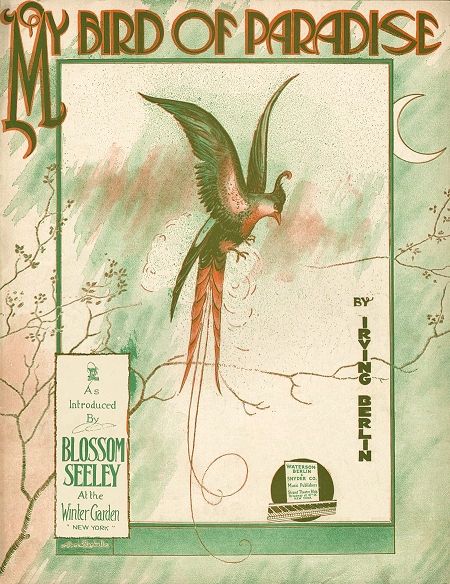 Maid in America ran from February through May for 108 performances, a fairly good run at that time. It was enough for Blossom to get her picture featured on a few more sheet music covers, including the widely circulated My Bird of Paradise. At the end of year, rather than go on tour with Rube, she accepted a featured part in producer Ned Wayburn's latest musical comedy revue, Ned Wayburn's Town Topics. It ran from mid-September through November for 68 performances before shutting down.
Maid in America ran from February through May for 108 performances, a fairly good run at that time. It was enough for Blossom to get her picture featured on a few more sheet music covers, including the widely circulated My Bird of Paradise. At the end of year, rather than go on tour with Rube, she accepted a featured part in producer Ned Wayburn's latest musical comedy revue, Ned Wayburn's Town Topics. It ran from mid-September through November for 68 performances before shutting down.
 Maid in America ran from February through May for 108 performances, a fairly good run at that time. It was enough for Blossom to get her picture featured on a few more sheet music covers, including the widely circulated My Bird of Paradise. At the end of year, rather than go on tour with Rube, she accepted a featured part in producer Ned Wayburn's latest musical comedy revue, Ned Wayburn's Town Topics. It ran from mid-September through November for 68 performances before shutting down.
Maid in America ran from February through May for 108 performances, a fairly good run at that time. It was enough for Blossom to get her picture featured on a few more sheet music covers, including the widely circulated My Bird of Paradise. At the end of year, rather than go on tour with Rube, she accepted a featured part in producer Ned Wayburn's latest musical comedy revue, Ned Wayburn's Town Topics. It ran from mid-September through November for 68 performances before shutting down.From there she went immediately to a Charles Dillingham production, Stop! Look! Listen!, which between Christmas Day and late March ran for 105 performances. By the middle of 1916 Blossom was back in vaudeville, but largely on her own for now. Reports vary on just when, but as early as the summer of 1916 Blossom and Rube separated, connecting on only occasion over the next couple of years, until their relationship more or less evaporated in 1918. In the summer of 1916, she introduced the first of what would become a string of hits from composers Richard Whiting and Raymond Egan, Mammy's Little Coal Black Rose. The pair would go on to write many popular songs, including some for Al Jolson.
Blossom slowly grew her reputation as a saucy vaudeville singer in her own production who sizzled on the stage. Among those she traveled with was cornetist Ray Lopez. According to a full-page advertisement in the New York Clipper of August 22, 1917, her troupe was "a distinct combination comprising class, originality and the highest extreme in musical and vocal ability. Not a jazz band, but a Group of Talented Artists. Every one a Star." Interestingly, the second billing on that notice went to "Benny Fields (Himself)," who would continue to have that position for many years to come.
By 1918 or 1919 Seeley was able to command around $1,500 a week for herself, similar to the amount that Nora Bayes and Fannie Brice were getting. In July of 1919 she was again a featured star, this time in the Greenwich Village Follies, a small but significant intimate off-Broadway affair that was produced by John Murray Anderson. For the next year she circulated largely through New York and Chicago, with notices of her appearances frequently found in the newspapers for both cities.
By 1920 Blossom may have tired of the drag on her reputation being married to Marquard, who had evidently not been in the picture for a while and whose career was going the opposite direction of Blossom's. According to the New York Times of April 20 in a story filed from Chicago, Illinois, "Mrs. Blossom C. Marquard, known in vaudeville as Blossom Seeley, today filed suit for divorce from Richard (Rube) Marquard, pitcher for the Brooklyn Baseball Club. She charged desertion since 1918." The news from Chicago later that year on August 16 read: "Alleging her husband, Richard ('Rube') Marquard, Brooklyn baseball pitcher, deserted her in 1918, Blossom Seeley, vaudeville headliner, today asked a divorce. The presiding Judge indicated he would sign the decree within a few days." Blossom was given custody of Richard, Jr., but ultimately he continued to live in Ohio with Rube's sister Hattie. While they did divorce, the pair did start corresponding again, and letters spanning a period of fifty years were later discovered, shedding light on a long post-divorce friendship that lasted until her death.
The Right Man and True Stardom
There was another addition to Blossom's act, and her life, in the wings in 1921, part of which may have been her motivation for leaving Marquard.
Just a few months after her divorce, the following item, which may have seemed like a rehash to some readers, appeared in the New York Times on March 10, 1921:
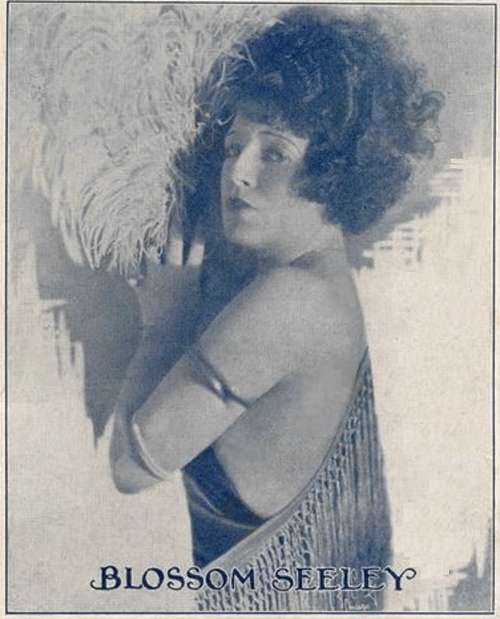 |
BLOSSOM SEELEY WEDS BENNY FIELDS
Blossom Seeley, vaudeville actress, today announced her marriage to Benjamin E. Geisenfeld of Milwaukee, her dancing partner, known on the stage as Benny Fields. A civil ceremony was performed in Chicago three weeks ago and the religious ceremony was held here today. Miss Seeley formerly was the wife of Rube Marquard, major league pitcher.
Benjamin Geisenfeld, born in 1894 in Milwaukee, Wisconsin, was around nine years younger than Blossom. Originally a cornetists, then singer, by the mid-1910s he had adopted the stage name of Bennie Fields (later as Benny), and with his unique talent was getting some traction working in Chicago dives. One of these was entrepreneur Al Tierney's Café on 22nd street, and perhaps Tierney's Grand Auto Inn at 338 East 35th Street. Both were located in predominantly black neighborhoods, but catered to a mixed clientele. Graduating from there, Fields managed to get on the Orpheum circuit by 1917. According to his draft card that same year, Benny had bad eyes, making him ineligible for service, and he too was already married, as was Blossom at that time. His style was, simply put, crooning. In fact, in later years, Bing Crosby paid tribute to Benny Fields as the original crooner who actually influenced the style of those who followed, including himself and Frank Sinatra. His stage presence, however, was more easygoing than it was commanding, which could be viewed as a glass ceiling in vaudeville.
There is no definite time that Seeley first encountered him, but it was just as likely in Chicago as it was on the circuit, where they would have often crossed paths.The first notice found of them on the same bill was in the New York Clipper advertisement of August 1917. Given that he was billed second to Blossom, she had evidently worked with him for at least a few months.
After Fields’ initial hire, which was part of a trio including Jack Salisbury and Benny Davis, Blossom was eventually taken enough with his style that she placed him as a backup duet vocalist to supplement her singing. However, at times he was to accompany her from the wings, rather than on stage. The gimmick worked, but from time to time Benny came out front to do a solo, and by early 1919 he and Blossom were performing duets together on stage.
Fields' temperament may have also appealed to Blossom since he hardly seemed overbearing or explosive, but very accepting of her occasional volatility. The contrast in their voices, his mellow backing to her syncopated explosiveness, also grew notice from theater goers. It was all enough to convince Blossom to take on yet another stage partner in yet another marriage. The difference was that this one would last around 38 years, and would eventually see a reversal in their roles both on and off stage.
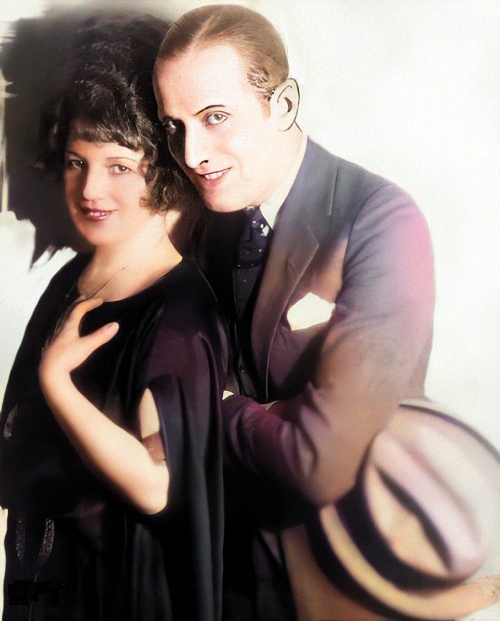 |
Starting in 1921 Blossom recorded more sides for Columbia records - just one the first year, but a total of 14 by 1926. Her accompanist at that time was usually the popular song writer Harry Stover. She was one of the first female vocalists to record the jazz standard Way Down Yonder in New Orleans in 1922, the year it was first featured in the show Spice of 1922. The cover featured one of Seeley's sexiest poses to date, holding up a large feather fan behind her head. Another number she performed to great satisfaction at that time, albeit not on record, was Chicago (That Toddlin' Town), which also featured her on a cover shot. While Seeley and Fields, and more often they were becoming billed as Fields and Seeley, continued to grow in popularity, it was Blossom who was still doing the records. In 1924 she recorded four sides with The Georgians, considered to be one of the first true jazz orchestras. Their trumpeter, Frank Guarente, was considered the star attraction, but their pianist, novelty composer Arthur Schutt, also deserves special mention for his challenging arrangements, some of the best in early jazz recordings. Seeley demonstrated some of her smoothest blues and jazz work on those four sides.
The biopic of Fields and (mostly) Seeley, Somebody Loves Me, is named after the George Gershwin song of the same title. The account in the movie, that Gershwin wrote the piece for Seeley, is more likely a bit of folklore, as is much of the story line. That song was first included in a Broadway revue composed largely by Gershwin with lyricists Buddy G. De Sylva and Ballard Macdonald, George White's Scandals of 1924.There is no mention of Blossom being in that show, and no dedication of the piece to her, so this story is hard to substantiate. In fact, Seeley would not record the piece until an accompanying album was created for the movie in 1952.
However, since she was acquainted with Gershwin, the story cannot be fully discounted either, so it remains as another mystery for now. Two songs that she did much to popularize in 1925 when they first came out were the still performed Yes Sir, That's My Baby and Alabamy Bound. In fact, even though Al Jolson was featured on the cover of Alabamy Bound, and had also recorded it, Seeley's rendition eclipsed it, rising to the number two spot at one point.
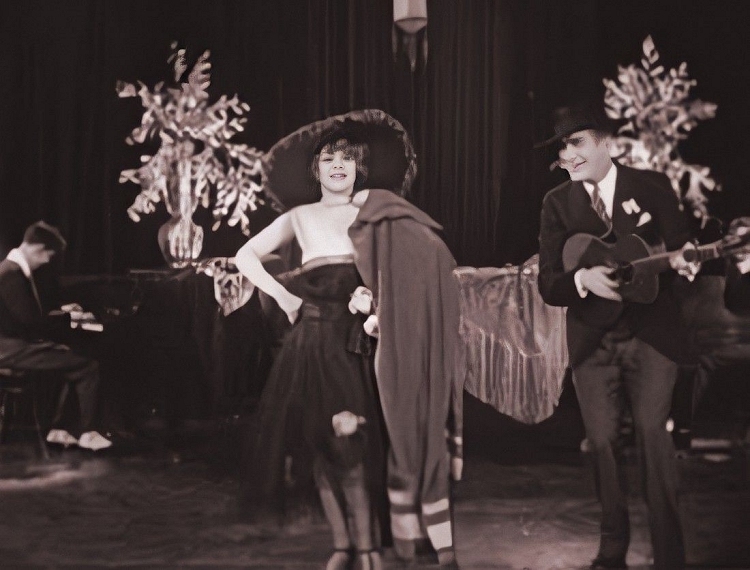 |
Vaudeville lived to a ripe old age, being a continuous form of entertainment for around a century. The year 1927 was regarded as the 100th anniversary of American vaudeville. It was only fitting that the top stars of the genre celebrate the event at what was considered the top vaudeville theater at that time, The Palace at 1564 Broadway. According to the New York Times of March 15, 1927, Blossom Seeley and Benny Fields (in that order) were the headliners for the celebration. Playing the Palace was considered to be the pinnacle of success for most performers (Al Jolson never did officially play the Palace), but headlining such a show was perhaps the only way to top that experience. Yet at that very moment there were plans being made in California that would both preserve many vaudeville acts for posterity, yet at the same time ensure its demise.
Warner Brothers had been producing synchronized sound shorts since mid-1926, and they were now working on their first sound feature film, The Jazz Singer. Their system, which was a 16" record synchronized to a reel of film, was called Vitaphone. In order to help popularize the new technology in the best possible way, Warner Brothers spent a lot of 1926 through 1929 in New York recording various vaudeville acts to Vitaphone shorts. Since these acts were already established, the studio did not need to hire extra musicians, 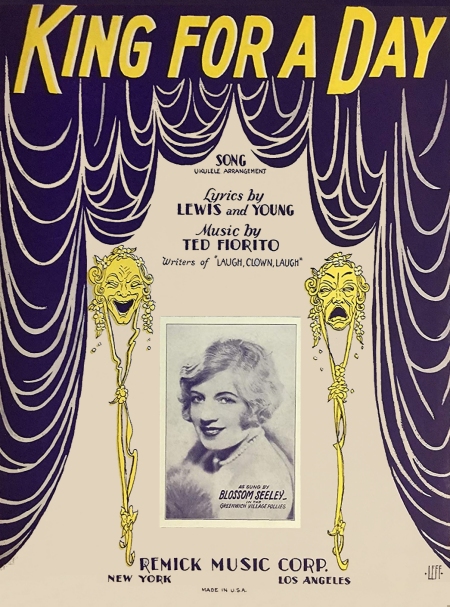 composers, script writers, etc., and the novelty of the sound films was enough to attract the entertainers without them demanding too much outlay. The Vitaphones not only demonstrated some of the best of vaudeville acts of the late 1920s, but they in many cases gave a plethora of reasons why such entertainment was doomed in light of the possibilities of feature films with sound as entertainment.
composers, script writers, etc., and the novelty of the sound films was enough to attract the entertainers without them demanding too much outlay. The Vitaphones not only demonstrated some of the best of vaudeville acts of the late 1920s, but they in many cases gave a plethora of reasons why such entertainment was doomed in light of the possibilities of feature films with sound as entertainment.
 composers, script writers, etc., and the novelty of the sound films was enough to attract the entertainers without them demanding too much outlay. The Vitaphones not only demonstrated some of the best of vaudeville acts of the late 1920s, but they in many cases gave a plethora of reasons why such entertainment was doomed in light of the possibilities of feature films with sound as entertainment.
composers, script writers, etc., and the novelty of the sound films was enough to attract the entertainers without them demanding too much outlay. The Vitaphones not only demonstrated some of the best of vaudeville acts of the late 1920s, but they in many cases gave a plethora of reasons why such entertainment was doomed in light of the possibilities of feature films with sound as entertainment.Blossom and Benny made one of these Vitaphones of part of their act in May 1927 on a simple stage with two concert grand pianos played by "The Music Boxes," pianists Charles Bourne and Phil Ellis. Benny does his best to keep up on the jazzy opening, Hello Bluebird, on which Blossom demonstrates her strutting and finger snapping and thigh slapping, along with some fine jazz licks. They aptly demonstrate their subtle call and response duets on The Call of the South, which clearly shows Benny's smooth backing vocals. He pulls out the guitar for their finale, In a Little Spanish Town, which is considerably altered from a waltz into a jazzy dance tune. Then they bow and exit. Vitaphone #548, Blossom Seeley and Bennie Fields with The Music Boxes was eventually released in 1928 [available from Warner Home Video on a Vitaphone bonus disc with The Jazz Singer DVD] and was the only known performance they did for that studio.
Blossom had a starring role again on Broadway in the Greenwich Village Follies of 1928, which ran from April through July for a respectable 128 performances. For the remainder of the year, she and Benny continued on the circuit. However, bookings were starting to diminish as more theaters throughout the country converted to sound, over 1800 of them by the end of 1928. Vaudeville in general saw smaller audiences in 1929, and when the Great Depression started to take hold in 1930, even the Palace Theater was offering more shows for less money in order to attract any kind of audience. Most of the vaudeville acts, such as Jack Benny, George Burns and Gracie Allen, and even Eddie Cantor, were moving towards film and away from the stage. Florenz Ziegfeld lost much of his considerable fortune in the 1929 crash on Wall Street, and his celebrated Follies was also in steep decline.
By 1933, Seeley and Fields decided to pursue disparate careers while remaining married. Benny's crooning style was well suited for radio, and he soon appeared several times on The Ziegfeld Follies of the Air and other New York based radio shows. That same year Blossom made three films that were well suited to her dynamic style, at least two of them specifically about Broadway and vaudeville. She and Benny appeared as themselves in a film hosted by Ed Sullivan titled Mr. Broadway. Following these films, she faded into the background and supported Benny's continuing success.
Lean Times
The Fields were living in Chicago, Illinois, in 1935. By late in the year Blossom and Benny followed many of their friends and peers out to Hollywood, but work was hard to come by.
They managed the occasional musical short or nostalgic appearance, but little else. It may have been at the insistence of their friend George Burns, who with his wife Gracie was now doing very well in Paramount produced pictures, that Fields was included in the 1936 film The Big Broadcast of 1937 starring Jack Benny. This was the third in a series of movies ironically about radio stars, and Fields did fairly well in it, crooning Here's Love in Your Eye for the microphone. Benny, now considered a capable soloist, recorded four sides for Decca Records that same year, and eight for the Variety label in 1937. Hollywood was not for the couple, however, and they retreated to New York permanently by 1938. The 1940 census shows them living in the Hotel Warwick in Manhattan, with Blossom as a song arranger and Benny as a theater actor.
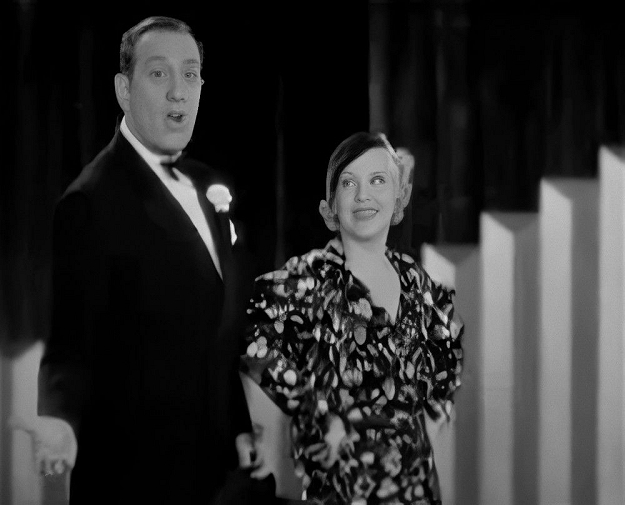 |
In 1941 Benny was hired to record four Soundies, short films which were essentially the parents of today's music videos installed in Soundie jukeboxes around the country. Two of them were songs from The Big Broadcast of 1937. After that, little was heard from Fields and Seeley for the next several years. Then in 1944, Producers Releasing Corporation (PRC), a small production company, crafted the film Minstrel Man around Benny's singular talent. While his acting did not receive many kudos, his singing performances did in the surprise hit. At least one critic described Benny as "a talent, voice, and personality the screen's been too long without." Benny's career was revived for a time on radio, and PRC planned a follow up that would be the biographical story of Blossom and Benny, a project that eventually was shelved. The couple did push their own revival a bit, landing an album with MGM records in 1947. It featured songs dating back to the ragtime era, including lovely duets of For Me and My Gal and By the Light of the Silvery Moon. But the clear highlight was Benny's solo rendition of The Lullaby of Broadway. For the most part, post-war entertainment in the late 1940s was struggling to find a center, and no particular genre stood out. The 1947 recordings were just a bit premature for the nostalgic revival that would start in 1950 on records, and was already underway in films.
So it was that by 1951 Blossom and Benny were struggling to survive in retirement. George and Gracie visited them in New York and found their current situation to be deplorable. He was already a major radio and film star who had made the transition to television with Gracie, and had some pull. So, at the insistence of George, and with his support, he sold Paramount Pictures on the idea of a Seeley and Fields biopic. Since the two Al Jolson biopics had done well, and MGM was cleaning up with nostalgic pictures by this time, it was not a hard sell. But as with many such films, Somebody Loves Me was a fictionalized version of their history. In most cases, such as with the Jerome Kern biopic Till the Clouds Roll By, many characters were melded into one and non-existent dilemmas were created to generate more of a dramatic story line. However, in the case of Somebody Loves Me, the real story was, for the most part, a little too saucy for audiences of that time. The end result was a picture starring Betty Hutton as Seeley and Ralph Meeker as Fields that had little resemblance to their actual life stories. In fact, Seeley was depicted as comparatively angelic and virginal, so much that Burns actually protested the treatment put on screen. Seeley, however, did not seem to mind. She responded to George's protests by noting that there was nothing she could do in advance about the future, but through such a portrayal she could at least fix her past. Blossom and Benny were also engaged by Decca Records to record eight tracks used in the film with their own voices, as Hutton's was of a somewhat different flavor.
Revival
In the mid-1950s, while visiting their friends in California, Benny and Blossom attended a house party thrown by George and Gracie, who were well known for their enjoyable affairs.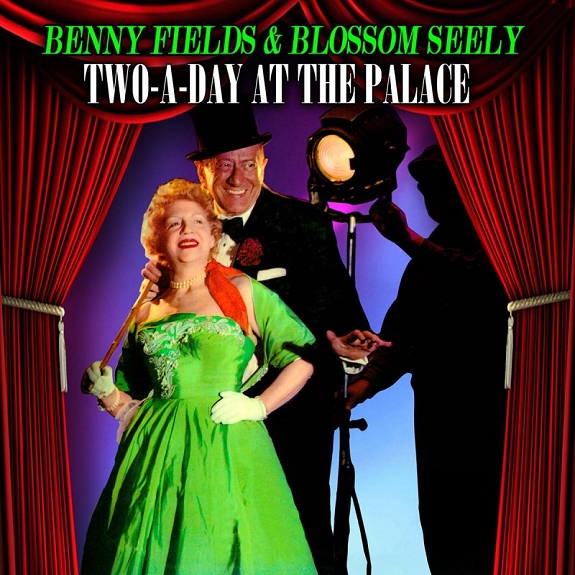 Several teenagers were also present, friends of the Burn's adopted children and the children of their friends. So, it was perhaps natural that when George asked them to do some of their old vaudeville act that they were reluctant to do so, given that the audience hardly seemed proper for something so archaic. However, they finally honored Burns' request, and ended up with a captivated audience, proving that good entertainment by good entertainers can transcend time. This was good incentive to convince them to make another album together. Benny Fields and Blossom Seeley - Two a Day at the Palace was released on the Mercury label in 1957 during the height of 1950s nostalgia.
Several teenagers were also present, friends of the Burn's adopted children and the children of their friends. So, it was perhaps natural that when George asked them to do some of their old vaudeville act that they were reluctant to do so, given that the audience hardly seemed proper for something so archaic. However, they finally honored Burns' request, and ended up with a captivated audience, proving that good entertainment by good entertainers can transcend time. This was good incentive to convince them to make another album together. Benny Fields and Blossom Seeley - Two a Day at the Palace was released on the Mercury label in 1957 during the height of 1950s nostalgia.
 Several teenagers were also present, friends of the Burn's adopted children and the children of their friends. So, it was perhaps natural that when George asked them to do some of their old vaudeville act that they were reluctant to do so, given that the audience hardly seemed proper for something so archaic. However, they finally honored Burns' request, and ended up with a captivated audience, proving that good entertainment by good entertainers can transcend time. This was good incentive to convince them to make another album together. Benny Fields and Blossom Seeley - Two a Day at the Palace was released on the Mercury label in 1957 during the height of 1950s nostalgia.
Several teenagers were also present, friends of the Burn's adopted children and the children of their friends. So, it was perhaps natural that when George asked them to do some of their old vaudeville act that they were reluctant to do so, given that the audience hardly seemed proper for something so archaic. However, they finally honored Burns' request, and ended up with a captivated audience, proving that good entertainment by good entertainers can transcend time. This was good incentive to convince them to make another album together. Benny Fields and Blossom Seeley - Two a Day at the Palace was released on the Mercury label in 1957 during the height of 1950s nostalgia.It was enough to get them booked on the iconic Ed Sullivan Show, which had one of the largest audiences in the country. They also started making live and recorded radio appearances again. Sullivan asked them back on three more occasions in 1957 and 1958. A review of some extant videos of those shows easily suggest that Blossom fit the mold of a female Al Jolson in many respects, quite the contrast to Benny’s low-key crooning demeanor. Benny recorded one more album recalling the days of vaudeville and minstrelsy. Benny Fields and His Minstrel Men was an all-star affair with Burns and Jack Benny, and younger stars Phil Silvers and Milton Berle. His crooning was clearly a highlight of this record, the first released on the short lived Colpix label, a subsidiary of Columbia Pictures.
The two albums of 1957 and 1958 were successful enough that, added to the buzz the couple got from their Ed Sullivan appearances, a revival of their career seemed in order. They both appeared on the Gary Moore Show as themselves, along with Jack Benny, in March or 1959. During the summer they spent a month performing in Las Vegas, Nevada at the Desert Sands.
With great plans for the 1959 to 1960 television season, and perhaps another recording in their future, Benny went to a rehearsal for Ed Sullivan to be broadcast on August 16. He was hospitalized that evening after suffering a massive heart attack, and died on Sunday, the same day he was to be on the show. Benny was buried in his hometown of Milwaukee.
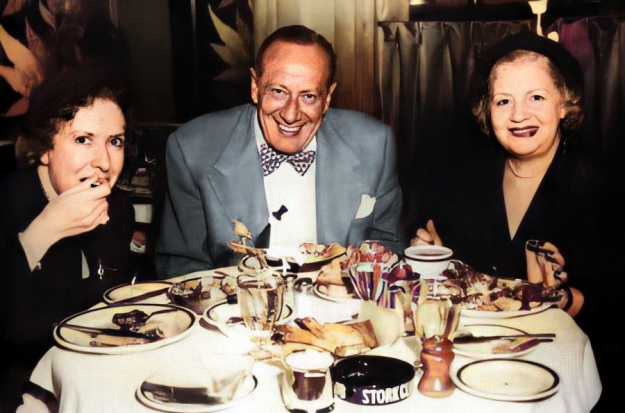 |
In his obituary there were quotes from Fields concerning his long life with Blossom. Describing the success of their marriage, Benny put it this way: "If two married people start getting jealous of each other's career, they don't have a marriage. They've just got a financial arrangement." Offering a rule for married people, Benny said, "One thing we always avoid is the word 'always,' - you know, 'you're always late,' or 'you're always griping' or 'you're always at the ball game.'" Fields added, "That's about the only rule for successful marriage I can think of offhand, except to pick a girl like Blossom."
Blossom was initially devastated at having lost the true love of her life after 38 years, but was able to recover sufficiently so that by November she made a solo appearance on Sullivan in honor of her late husband. She proved to be popular enough with her revival of days gone by, and her voice and performances still captivated audiences. More appearances on Sullivan and other variety shows continued into the mid-1960s, but her audiences were diminishing in light of the social and musical changes of that era, and her star finally faded for good.
Little is known of her last few years except for her correspondence with Marquard, which revealed a touching and lasting friendship. Blossom Seeley took her final bow in April 1974 at age 87, then, as they say in vaudeville at the end of a run, she got her pictures back, making room for the next act. America lost a true treasure, but she did leave a very real legacy behind of a life in ragtime and beyond, proving the durability of the genre and its stars.
Some interesting information on Seeley and Fields was taken from the Internet Broadway Database and the Internet Movie Database. Further information on Blossom and Rube Marquard can be found in many books on Marquard. A little of the history of Blossom in vaudeville came from Vaudeville, Old and New by Frank Cullen, Florence Hackman and Donald McNeilly. Some of the better stories on the couple, not all included here, can be found in the writings of their great friend George Burns.
Special Thanks also go to Carol Albrikes, great niece of Blossom through her grandfater, James L. Lonergan, who helped to nail down the best possible birth information for Blossom, leading to other revelations. This includes the birth registry and marriage information for Blossom's parents brought to our attention by Gary Wilson who discovered it. Also, Rich Martin of Archeophone Records who provided some stimulating conversation on Blossom's early years that helped to clarify several points.
The majority of the information here came from public records, individually cited newspaper accounts, magazine articles and reviews, investigative searches by the author, and period recording logs.


 Compositions
Compositions